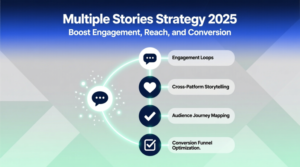In 2025, social media has become a battlefield for attention. Single posts or isolated stories aren’t enough to cut through the noise anymore. The Multiple Stories Strategy has emerged as a game-changer for brands, content creators, and marketers. By weaving together several stories, sequenced across platforms or within one channel, you can maximize engagement, increase reach, and drive conversions.
In this guide, we’ll dive deep into what a Multiple Stories Strategy is, why it matters in 2025, how to implement it, and examples of brands that are doing it right. Whether you’re a marketer, small business owner, or influencer, this article will give you practical insights to start using multiple stories effectively today.
What Is the Multiple Stories Strategy?
A Multiple Stories Strategy is the intentional creation and sequencing of multiple story posts on platforms like Instagram, Facebook, TikTok, or LinkedIn to convey a cohesive narrative or campaign. Instead of posting a single story or random content, this approach focuses on:
- Sequencing stories logically to maintain audience interest.
- Cross-platform storytelling to increase visibility.
- Diverse content types to engage different audience segments.
For example, a beauty brand launching a new prouct might create a series of stories:
- Teaser Story – hints at the product launch.
- Behind-the-Scenes Story – shows how the product is made.
- Demo Story – highlights key features and benefits.
- User Testimonials Story – shares real-life reviews.
- CTA Story – encourages purchase or signup.
| Aspect | Single Story Approach | Multiple Stories Strategy |
| Audience Engagement | Low to moderate | High – keeps viewers returning |
| Story Depth | Limited | Multi-dimensional, narrative-driven |
| Conversion Potential | Low | High – builds trust and leads |
| Platform Reach | Restricted | Optimized across platforms |
This strategy is about creating a journey for your audience instead of delivering isolated content pieces.
Why Brands Need a Multiple Stories Strategy in 2025
The digital landscape has shifted dramatically. Short attention spans, overflowing feeds, and complex algorithms make it harder for brands to stand out. Here’s why multiple stories matter now more than ever:
Increased Engagement
Audiences are more likely to interact with content that tells a story or unfolds in a sequence. A single story may capture attention briefly, but a series of stories can build suspense, curiosity, and loyalty.
Algorithm Advantage
Platforms like Instagram and TikTok reward frequent, engaging content. Posting multiple, high-quality stories increases your chances of appearing in more feeds and boosting discoverability.
Flexibility and Creativity
Multiple stories allow brands to experiment with formats, visuals, and messaging. You can mix behind-the-scenes content, interactive polls, quizzes, tutorials, or user-generated content to keep your audience engaged.
Cross-Platform Reach
You can adapt stories for different platforms to target varied audience segments. For instance, a TikTok story might be a short video demo, while the Instagram story can include polls and links for engagement.
Key Benefits:
- Increased reach and impressions
- Higher engagement rates
- More effective storytelling
- Better audience retention and loyalty
Key Elements of an Effective Multiple Stories Strategy
A Multiple Stories Strategy isn’t just posting randomly; it requires planning, creativity, and analytics. Here are the main elements that make it effective:
Content Planning & Sequencing
Mapping out the story sequence ensures each story flows naturally into the next. Consider story arcs like:
- Hook → Problem → Solution → CTA
- Teaser → Reveal → Testimonial → Engagement
Audience Segmentation
Not every story resonates with everyone. Segment your audience based on demographics, interests, or behaviors, and tailor stories accordingly.
Timing & Frequency
Posting too much can overwhelm your audience, while posting too little may reduce visibility. Test different posting schedules, considering time zones and platform activity peaks.
Visual Consistency & Branding
Use consistent colors, fonts, and brand elements so stories are immediately recognizable. This builds brand familiarity even in crowded feeds.
Calls-to-Action (CTAs)
Every story should guide viewers toward an action, whether it’s visiting a website, signing up, participating in a poll, or purchasing a product.
Example Diagram – Story Flow:
[Teaser Story] -> [Behind-the-Scenes] -> [Product Demo] -> [User Testimonial] -> [CTA]
This simple structure keeps your audience engaged and guided through a journey.
Types of Stories to Include
Diversity in story content keeps audiences engaged. Here are the most effective story types for 2025:
- Behind-the-Scenes: Builds authenticity and trust.
- User-Generated Content (UGC): Highlights real customers and increases social proof.
- Tutorials / How-Tos: Educates your audience while subtly promoting your product.
- Product Launches: Generates hype and anticipation.
- Interactive Stories: Polls, quizzes, stickers, and AR filters boost engagement.
| Story Type | Objective | Ideal Platform |
| Behind-the-Scenes | Build trust and authenticity | Instagram, TikTok, LinkedIn |
| User-Generated Content | Social proof, community building | Instagram, Facebook |
| Tutorial / How-To | Education, problem-solving | TikTok, YouTube, Instagram |
| Product Launch | Awareness and excitement | All platforms |
| Interactive Stories | Engagement and feedback | Instagram, TikTok |
By rotating different story types, you maintain audience interest while reinforcing your brand message.
How to Measure the Success of Your Multiple Stories Strategy
Tracking results is essential. Here’s how to measure success effectively:
Key Metrics
- Reach & Impressions: How many people saw your stories?
- Engagement Rate: Likes, reactions, replies, and shares.
- Click-Through Rate (CTR): How many people followed your lins?
- Conversions: Sales, signups, or other business goals achieved.
Tools to Track Analytics
- Instagram Insights
- Facebook Analytics
- TikTok Analytics
- Third-party tools: Hootsuite, Sprout Social, Later
Sample Analytics Dashboard:
| Metric | Target Value | Actual Value | Notes |
| Reach | 50,000 | 55,200 | Exceeded target |
| Engagement Rate | 8% | 10% | Interactive polls performed well |
| Click-Through Rate | 3% | 2.8% | Slightly below expectation |
| Conversions | 500 | 520 | Successful CTA execution |
Common Mistakes to Avoid
Even the best strategies can fail if executed poorly. Avoid these common pitfalls:
- Overposting or spamming your audience
- Ignoring story sequence planning
- Not adapting content for each platform
- Lack of visual consistency
- Neglecting audience interaction
Staying consistent, tracking results, and adjusting your approach ensures your strategy performs optimally.
Advanced Tips for 2025
The landscape keeps evolving. Here are some cutting-edge tips:
- AI-driven content scheduling: Tools can predict the best times and formats for posting.
- Cross-platform integration: Repurpose stories across Instagram, TikTok, LinkedIn, and YouTube Shorts.
- Interactive features: Use polls, quizzes, and AR filters to boost engagement.
- Analytics-driven storytelling: Track audience behavior to refine story sequencing and topics.
These strategies allow brands to stay ahead of the curve and maximize engagement.
Case Studies of Brands Excelling in Multiple Stories Strategy
Glossier
- Launched a new skincare product with a 5-story sequence on Instagram.
- Stories included teaser, behind-the-scenes, demo, UGC, and CTA.
- Result: 20% increase in engagement and 15% higher conversion rates than previous launches.
Nike
- Used TikTok and Instagram stories for a campaign targetig Gen Z.
- Combined interactive quizzes and user-submitted videos.
- Result: Reach exceeded 1.2 million and boosted brand sentiment significantly.
Starbucks
- Rolled out a holiday drink campaign with multiple stories featuring barista insights, polls, and limited-time offers.
- Result: Increased story completion rates by 30%, leading to higher in-store visits.
Lessons from these examples: sequenced storytelling, audience interaction, and cross-platform consistency drive results.
Step-by-Step Guide to Implementing Your Own Multiple Stories Strategy
Step 1: Define Goals and Audience
- Identify business objectives: awareness, engagement, or sales.
- Segment your audience to tailor stories effectively.
Step 2: Plan Content Types and Sequence
- Decide which story types to include.
- Plan a logical flow to keep your audience engaged.
Step 3: Design Visuals and Draft Copy
- Ensure visual branding consistency.
- Keep copy short, clear, and engaging.
Step 4: Schedule and Post Across Platforms
- Use analytics tools to schedule at optimal times.
- Adapt each story for different platform formats.
Step 5: Track, Analyze, and Adjus
- Measure reach, engagement, CTR, and conversions.
- Refine story sequences and types based on audience response.
Implementation Checklist Table:
| Task | Status |
| Define goals and audience | ✅ |
| Plan content types & sequence | ✅ |
| Design visuals & draft copy | ✅ |
| Schedule & post | ✅ |
| Track & adjust | ✅ |
Conclusion
The Multiple Stories Strategy in 2025 is no longer optional. It’s essential for brands and content creators who want to stand out, engage audiences, and drive results. By planning your story sequence, diversifying content, leveraging cross-platform opportunities, and analyzing performance, you can create a compelling narrative that converts.
Start small, test your approach, and scale strategically. Your audience is ready to follow the journey—are you ready to lead it?
FAQs
Q: How many stories should I post per day?
A: It depends on your audience and platform. For Instagram, 3–7 stories per day is ideal. For TikTok, 1–3 stories may be sufficient.
Q: Can multiple stories work for small businesses?
A: Absolutely. Even with limited resources, planning 2–3 stories strategically can boost engagement and conversions.
Q: Should stories be identical across platforms?
A: No. Adapt content to fit platform format, audience behavior, and engagement features.
Q: How do I measure story ROI?
A: Track metrics like reach, engagement rate, click-throughs, and conversions. Combine qualitative feedback for deeper insights.

“Emma Rose invites you to dive into the world of laughter at PunnyFunnys.com, where clever puns and light-hearted jokes take center stage. With her unique touch of humor, Emma crafts the perfect blend of wordplay and wit to make sure you’re always smiling. Whether you’re here for a quick giggle or to brighten someone’s day, Emma Rose’s collection of jokes will never fail to bring joy. Explore the fun side of life with PunnyFunnys, and let the laughs flow!



